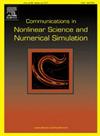庞卡罗映射范式的显式数值计算
IF 3.4
2区 数学
Q1 MATHEMATICS, APPLIED
Communications in Nonlinear Science and Numerical Simulation
Pub Date : 2025-05-10
DOI:10.1016/j.cnsns.2025.108913
引用次数: 0
摘要
我们提出了一种在离散系统中计算范式的方法,例如那些由庞卡罗图描述的系统。我们的方法首先计算气流相对于初始条件和参数的高阶导数,这些导数是通过射流传输获得的,然后将适当的投影应用到庞加莱剖面上,以推导出地图的功率展开。在第二步中,我们执行坐标变换以简化围绕动态对象的局部幂展开,仅保留谐振项。由此产生的范式提供了对象周围动态的局部描述,并显示了其对参数的依赖性。值得注意的是,这种方法除了充分的规律性外,没有假设系统的任何特定结构。为了说明其有效性,我们首先考察著名的hsamnon - heiles系统。通过固定一个能级并使用一个空间庞卡罗剖面,系统被表示为一个二维的庞卡罗图。以该映射的椭圆不动点为中心,我们计算了一个高阶范式,这是一个显式得到的扭转映射。这意味着我们已经计算出了庞卡罗截面能级内的不变环面。此外,我们探讨了不动点和范式如何依赖于poincar本文章由计算机程序翻译,如有差异,请以英文原文为准。
Explicit numerical computation of normal forms for Poincaré maps
We present a methodology for computing normal forms in discrete systems, such as those described by Poincaré maps. Our approach begins by calculating high-order derivatives of the flow with respect to initial conditions and parameters, obtained via jet transport, and then applying appropriate projections to the Poincaré section to derive the power expansion of the map. In the second step, we perform coordinate transformations to simplify the local power expansion around a dynamical object, retaining only the resonant terms. The resulting normal form provides a local description of the dynamics around the object, and shows its dependence on parameters. Notably, this method does not assume any specific structure of the system besides sufficient regularity.
To illustrate its effectiveness, we first examine the well-known Hénon–Heiles system. By fixing an energy level and using a spatial Poincaré section, the system is represented by a 2D Poincaré map. Focusing on an elliptic fixed point of this map, we compute a high-order normal form, which is a twist map obtained explicitly. This means that we have computed the invariant tori inside the energy level of the Poincaré section. Furthermore, we explore how both the fixed point and the normal form depend on the energy level of the Poincaré section, deriving the coefficients of the twist map as a power series of the energy level. This approach also enables us to obtain invariant tori inside nearby energy levels. We also discuss how to obtain the frequencies of the torus for the flow. We include a second example involving an elliptic periodic orbit of the spatial Restricted Three-Body Problem. In this case the map is 4D, and the normal form is a multidimensional twist map.
求助全文
通过发布文献求助,成功后即可免费获取论文全文。
去求助
来源期刊

Communications in Nonlinear Science and Numerical Simulation
MATHEMATICS, APPLIED-MATHEMATICS, INTERDISCIPLINARY APPLICATIONS
CiteScore
6.80
自引率
7.70%
发文量
378
审稿时长
78 days
期刊介绍:
The journal publishes original research findings on experimental observation, mathematical modeling, theoretical analysis and numerical simulation, for more accurate description, better prediction or novel application, of nonlinear phenomena in science and engineering. It offers a venue for researchers to make rapid exchange of ideas and techniques in nonlinear science and complexity.
The submission of manuscripts with cross-disciplinary approaches in nonlinear science and complexity is particularly encouraged.
Topics of interest:
Nonlinear differential or delay equations, Lie group analysis and asymptotic methods, Discontinuous systems, Fractals, Fractional calculus and dynamics, Nonlinear effects in quantum mechanics, Nonlinear stochastic processes, Experimental nonlinear science, Time-series and signal analysis, Computational methods and simulations in nonlinear science and engineering, Control of dynamical systems, Synchronization, Lyapunov analysis, High-dimensional chaos and turbulence, Chaos in Hamiltonian systems, Integrable systems and solitons, Collective behavior in many-body systems, Biological physics and networks, Nonlinear mechanical systems, Complex systems and complexity.
No length limitation for contributions is set, but only concisely written manuscripts are published. Brief papers are published on the basis of Rapid Communications. Discussions of previously published papers are welcome.
 求助内容:
求助内容: 应助结果提醒方式:
应助结果提醒方式:


